Comprehensive characterization of gas dynamic virtual nozzles for x-ray free-electron laser experiments
- PMID: 39606427
- PMCID: PMC11602214
- DOI: 10.1063/4.0000262
Comprehensive characterization of gas dynamic virtual nozzles for x-ray free-electron laser experiments
Abstract
We introduce a hardware-software system for rapidly characterizing liquid microjets for x-ray diffraction experiments. An open-source python-based software package allows for programmatic and automated data collection and analysis. We show how jet speed, length, and diameter are influenced by nozzle geometry, gas flow rate, liquid viscosity, and liquid flow rate. We introduce "jet instability" and "jet probability" metrics to help quantify the suitability of a given nozzle for x-ray diffraction experiments. Among our observations were pronounced improvements in jet stability and reliability when using asymmetric needle-tipped nozzles, which allowed for the production of microjects smaller than 250 nm in diameter, traveling faster than 120 m/s.
© 2024 Author(s).
Conflict of interest statement
The authors have no conflicts to disclose.
Figures




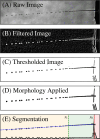




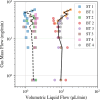
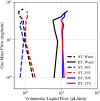



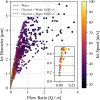
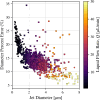




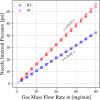

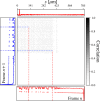
Similar articles
-
3D printing of gas-dynamic virtual nozzles and optical characterization of high-speed microjets.Opt Express. 2020 Jul 20;28(15):21749-21765. doi: 10.1364/OE.390131. Opt Express. 2020. PMID: 32752448 Free PMC article.
-
Alternative Geometric Arrangements of the Nozzle Outlet Orifice for Liquid Micro-Jet Focusing in Gas Dynamic Virtual Nozzles.Materials (Basel). 2021 Mar 23;14(6):1572. doi: 10.3390/ma14061572. Materials (Basel). 2021. PMID: 33807027 Free PMC article.
-
A liquid jet setup for x-ray scattering experiments on complex liquids at free-electron laser sources.Rev Sci Instrum. 2016 Jun;87(6):063905. doi: 10.1063/1.4953921. Rev Sci Instrum. 2016. PMID: 27370468
-
Ceramic micro-injection molded nozzles for serial femtosecond crystallography sample delivery.Rev Sci Instrum. 2015 Dec;86(12):125104. doi: 10.1063/1.4936843. Rev Sci Instrum. 2015. PMID: 26724070
-
Methods development for diffraction and spectroscopy studies of metalloenzymes at X-ray free-electron lasers.Philos Trans R Soc Lond B Biol Sci. 2014 Jul 17;369(1647):20130590. doi: 10.1098/rstb.2013.0590. Philos Trans R Soc Lond B Biol Sci. 2014. PMID: 24914169 Free PMC article. Review.
References
-
- Gañán-Calvo A. M., “ Generation of steady liquid microthreads and micron-sized monodisperse sprays in gas streams,” Phys. Rev. Lett. 80, 285–288 (1998).10.1103/PhysRevLett.80.285 - DOI
-
- DePonte D. P., Weierstall U., Starodub D., Schmidt K., Spence J. C. H., and Doak R. B., “ Gas dynamic virtual nozzle for generation of microscopic droplet streams,” J. Phys. D 41, 195505 (2008).10.1088/0022-3727/41/19/195505 - DOI
-
- Knoška J., Adriano L., Awel S., Beyerlein K. R., Yefanov O., Oberthuer D., Peña Murillo G. E., Roth N., Sarrou I., Villanueva-Perez P., Wiedorn M. O., Wilde F., Bajt S., Chapman H. N., and Heymann M., “ Ultracompact 3D microfluidics for time-resolved structural biology,” Nat. Commun. 11, 657 (2020).10.1038/s41467-020-14434-6 - DOI - PMC - PubMed
-
- Vakili M., Bielecki J., Knoška J., Otte F., Han H., Kloos M., Schubert R., Delmas E., Mills G., de Wijn R., Letrun R., Dold S., Bean R., Round A., Kim Y., Lima F. A., Dörner K., Valerio J., Heymann M., Mancuso A. P., and Schulz J., “ 3D printed devices and infrastructure for liquid sample delivery at the European XFEL,” J. Synchrotron Radiat. 29, 331–346 (2022).10.1107/S1600577521013370 - DOI - PMC - PubMed
-
- Chapman H. N., Fromme P., Barty A., White T. A., Kirian R. A., Aquila A., Hunter M. S., Schulz J., DePonte D. P., Weierstall U., Doak R. B., Maia F. R. N. C., Martin A. V., Schlichting I., Lomb L., Coppola N., Shoeman R. L., Epp S. W., Hartmann R., Rolles D., Rudenko A., Foucar L., Kimmel N., Weidenspointner G., Holl P., Liang M., Barthelmess M., Caleman C., Boutet S., Bogan M. J., Krzywinski J., Bostedt C., Bajt S., Gumprecht L., Rudek B., Erk B., Schmidt C., Hömke A., Reich C., Pietschner D., Strüder L., Hauser G., Gorke H., Ullrich J., Herrmann S., Schaller G., Schopper F., Soltau H., Kühnel K.-U., Messerschmidt M., Bozek J. D., Hau-Riege S. P., Frank M., Hampton C. Y., Sierra R. G., Starodub D., Williams G. J., Hajdu J., Timneanu N., Seibert M. M., Andreasson J., Rocker A., Jönsson O., Svenda M., Stern S., Nass K., Andritschke R., Schröter C.-D., Krasniqi F., Bott M., Schmidt K. E., Wang X., Grotjohann I., Holton J. M., Barends T. R. M., Neutze R., Marchesini S., Fromme R., Schorb S., Rupp D., Adolph M., Gorkhover T., Andersson I., Hirsemann H., Potdevin G., Graafsma H., Nilsson B., and Spence J. C. H., “ Femtosecond X-ray protein nanocrystallography,” Nature 470, 73–77 (2011).10.1038/nature09750 - DOI - PMC - PubMed
LinkOut - more resources
Full Text Sources

